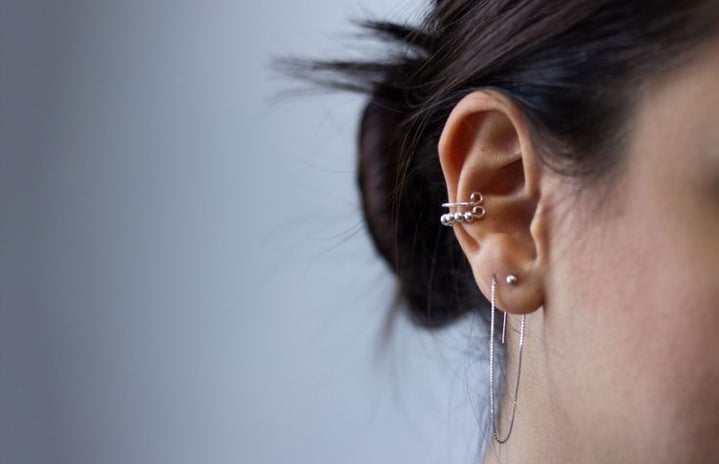On college campuses, it is a common sight to see ear piercings, nose rings, and belly button piercings galore. Piercings have become much more accepted in recent years (especially among young people), but it is still a big decision to get a piercing. If you are considering getting a shiny new piercing to debut as the weather warms up and shorts and crop tops return, here are a couple of tips that go more in-depth about 3 common piercing choices: ear, nose, and bellybutton.
- Decide what part of the body you want to pierce
-
The ear is the most common part of the body to pierce. From my experience, I have had my single, double, and triple lobes pierced. Having your ear lobes pierced is not very painful, but it can take a while to fully heal — 6 months to 1 year. Aside from the lobes, the next most common ear piercing is the cartilage piercing. I plan to have this piercing done soon, but based on my friends’ experiences it is slightly more painful than a lobe piercing. The healing for a cartilage piercing can be slightly more annoying as well since the piercing is located at the tip of your ear and can easily be bumped by a hairbrush or become irritated if you sleep on your side. Like the lobe piercing, it takes cartilage piercings about 6 months to a year to heal. There are many other places in the ear that can be pierced, but in general, expect ear piercings to be moderately painful and relatively easy to heal. Be prepared to clean your ear piercing about 3 times a day with saltwater spray for the duration of the healing process.
The nose is also a very common piercing choice. I got my nostril pierced with a diamond stud on my 18th birthday, and it is my favorite piercing. Since the nose is mainly cartilage, it did not hurt much to have pierced. In my experience, my piercing healed very quickly — about 4 months — but this process can take up to a year. The healing process should be minimally invasive since your nose does not experience much movement. However, be ready to take care when showering and washing your face, because getting your nose piercing snagged on a towel is horribly painful. Besides the nostril, another common nose piercing is a septum piercing, which is what some refer to as a “bull-ring” piercing. With a septum piercing, expect a similar healing process and pain level as with a nostril piercing. Be prepared to clean your nose piercing about 3 times a day with saltwater spray for the duration of the healing process.
The belly button piercing is somewhat less popular than ear and nose piercings but is recently making a comeback. This is my most recent piercing, and while it is adorable, it HURT. If pain and needles squick you out, I recommend that you pierce a less sensitive part of the body. If you do wish to get a belly button piercing, expect to experience a large shock of pain when the piercer clamps your bellybutton to hold it still while piercing the skin. The actual piercing itself is not very painful, but the clamp is quite intense. When it comes to care, the belly button piercing is one of the most high-maintenance options. Your torso and belly button experience a lot of movement, which can prolong the healing process. After being pierced, you should expect to reduce your physical activity until the piercing has become less painful and you feel comfortable moving. You also have to be very careful not to snag the piercing on any blankets or clothing. Like with a nose ring, your shower ritual slows down because you have to be mindful of snagging your piercing on towels. You also have to be mindful of what clothing you wear while the piercing heals, which could be anywhere from 6 months to 2 years. Avoid high-waisted clothing, shirts made of holes or knit material, and tight shirts. Low-rise bottoms, crop tops, and loose shirts are ideal for the healing process. Once the piercing is fully healed, you can wear whatever clothing you like. If you frequently lay on your stomach, be prepared to give that up until the piercing is fully healed. With a belly button piercing, you must be vigilant for signs of infection because the piercing is in a very vulnerable part of the body. Piercings that are healing well can have slight redness, some dry skin, moderate pain, and yellowish crust. Signs of an infection include intense redness, streaks of red on the skin surrounding the belly button, excruciating pain, and oozing. Be prepared to clean your belly button piercing 2 times a day in the shower with fragrance-free soap and 3 times a day with saltwater spray for the duration of the healing process.
- Consider if your lifestyle aligns with your piercing choice
-
If you are going into a field where piercings are looked down upon, consider how easy it is to remove your piercing. If a potential employer had an issue with your piercing, would you be willing to remove it or would you seek employment elsewhere? This is less of an issue for ear piercings, which can be easily taken out, and belly button piercings, which are hidden when wearing professional clothing. With nose piercings, it is possible to take them out but it is often more complicated than for ear piercings. If you are concerned with employers requiring you to take out your nose piercing, you can ask your piercer to provide you with a style of nose piercing that is easy to take out on your own. If you engage in sports or lots of physical activity, ask yourself if you are okay with refraining from certain exercises for a while. This is of most concern for swimmers, as piercings cannot be submerged in unclean water (which includes pools, lakes, and the ocean) for the duration of the healing process. For athletes who do not swim, the most bothersome piercing would be a belly button piercing since it is recommended to refrain from heavy lifting or strenuous activity until it is no longer painful to move your torso. If the piercing you want is incompatible with your lifestyle, choose a different piercing that matches your needs better.
- Be ready to care for your new piercing
-
Nothing is worse than paying for a piercing and enduring the pain only to neglect your aftercare, end up with an infection, and have to spend more money and be in more pain. It is imperative that you stick religiously to the cleaning regimen provided by your piercer. Furthermore, it is even more important that you stay away from unclean bodies of water. Piercings are essentially open wounds, so hopping into a bacteria-filled lake with a fresh piercing is a one-way ticket to a doctor visit. The cleaning process is most important for a belly button piercing, because when not cared for properly they are prone to infection. However, do not let that scare you away from getting a belly button piercing. As long as you keep it clean, wear minimally invasive clothing, and avoid unclean water sources, you should have minimal issues. If you feel that you will not be able to commit to the cleaning regimen needed for a certain piercing, get a less high-maintenance piercing.
- Know what to do if the piercing becomes infected
-
If you are seeing signs of infection like red streaking and oozing around your new piercing, head to the doctor ASAP. They will likely prescribe you some sort of antibiotic. If you are able to clear up the infection you can keep your piercing, just be ready to take better care of it in the future.
- Look for a reputable piercer
-
Your best bet is to go to a tattoo shop that has a piercing artist on-staff. Tattoo shops are among the cleanest and safest places to get a piercing as reliable ones use sterilized needles and have licenses to pierce. Signs of a good tattoo shop are: clean environment, brightly-lit, visible licenses and certificates, and the presence of sterilization equipment like autoclaves and cleaning products. Research the tattoo shop you wish to go to online beforehand. Helpful things to look at are shop reviews and the shop’s piercing portfolio (which should be easily accessible on their website or social media). When you arrive at the shop, do not hesitate to ask the piercing artist about their qualifications and how they learned to pierce. Any reputable piercer should be easily able to answer your questions. A good piercer should also be slow and delicate, asking if you are okay each step of the way during the piercing appointment. NEVER let a piercer use a piercing gun on you. Any self-respecting piercer will always use a sterilized needle because piercing guns are unsanitary and imprecise.
I hope you found these piercing tips helpful. Getting a piercing done is a big commitment and responsibility, but if taken care of properly they are a fun and youthful source of self-expression.



